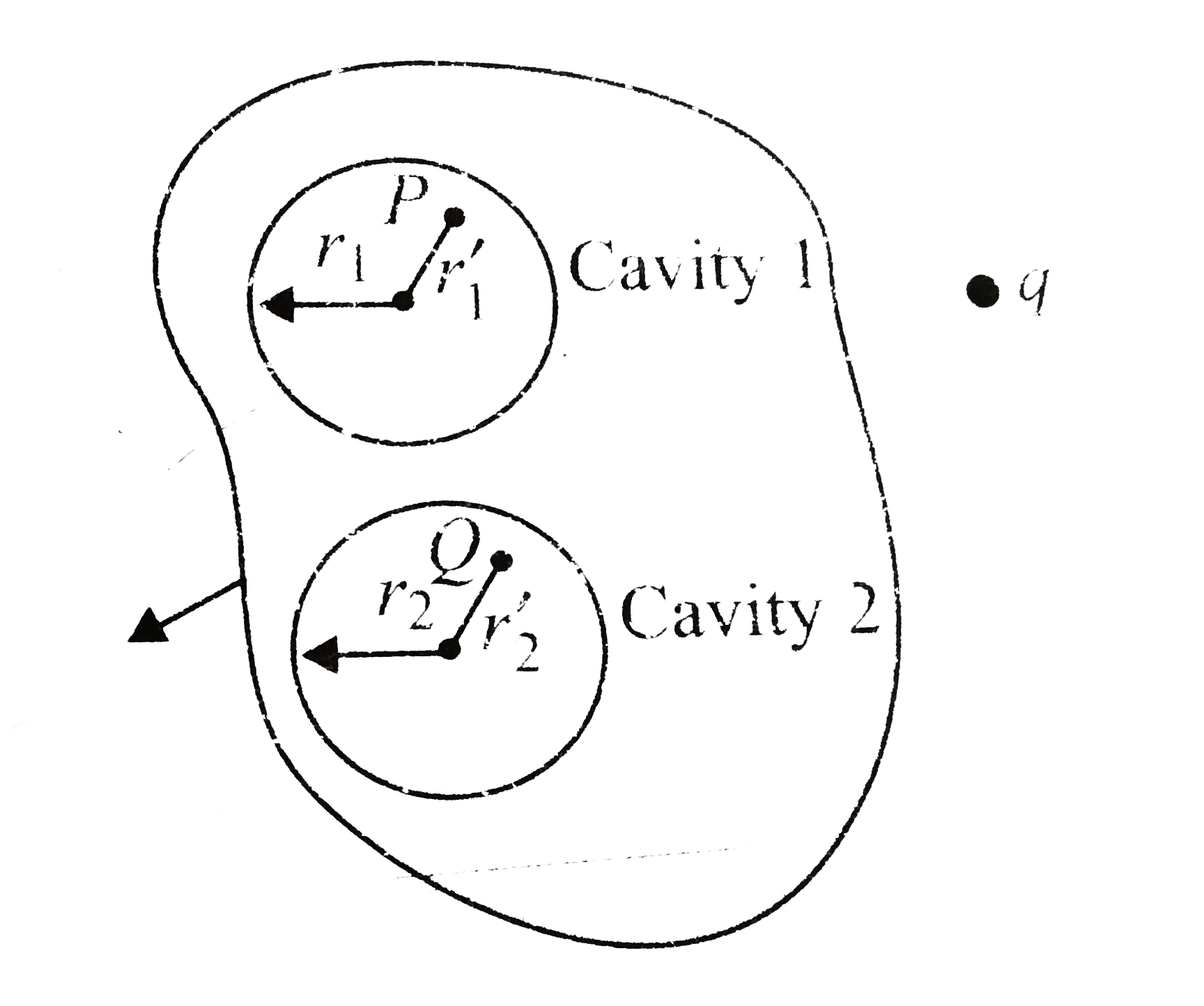A point charge q1=q is placed at point P. Another point charge q2=−q is placed at point Q. At some point R(R≠P,R≠Q), electric potential due to q−1isV1 and electric potential due to q2 is V2. Which of the following is correct
only for some points V1>V2
only fro some points V2>V1
for all points V1>V2
for all points V2>V1
The correct Answer is:C
To solve the problem, we need to analyze the electric potentials due to the two point charges at a point R, which is not equal to the locations of the charges P and Q.
1. Identify the Charges and Their Positions:
- We have two point charges:
- Charge q1=q (positive charge) located at point P.
- Charge q2=−q (negative charge) located at point Q.
2. Understanding Electric Potential:
- The electric potential V due to a point charge Q at a distance r is given by the formula:
V=kQr
where k is Coulomb's constant.
3. Calculate the Electric Potential at Point R:
- Let the distance from charge q1 (at P) to point R be r1 and the distance from charge q2 (at Q) to point R be r2.
- The electric potential V1 at point R due to charge q1 is:
V1=kqr1
- The electric potential V2 at point R due to charge q2 is:
V2=k−qr2
4. Comparing the Potentials:
- Since q1 is positive, V1 will be a positive value.
- Since q2 is negative, V2 will be a negative value.
- Therefore, we can conclude:
V1>0andV2<0
5. Conclusion:
- Since V1 (positive) is always greater than V2 (negative) for any point R that is not equal to P or Q, we can state that:
V1>V2for all points R
Final Answer:
The correct option is that V1 is greater than V2 for all points R.
- We have two point charges:
- Charge q1=q (positive charge) located at point P.
- Charge q2=−q (negative charge) located at point Q.
- The electric potential V due to a point charge Q at a distance r is given by the formula:
V=kQr
where k is Coulomb's constant.
- Let the distance from charge q1 (at P) to point R be r1 and the distance from charge q2 (at Q) to point R be r2.
- The electric potential V1 at point R due to charge q1 is:
V1=kqr1
- The electric potential V2 at point R due to charge q2 is:
V2=k−qr2
- Since q1 is positive, V1 will be a positive value.
- Since q2 is negative, V2 will be a negative value.
- Therefore, we can conclude:
V1>0andV2<0
- Since V1 (positive) is always greater than V2 (negative) for any point R that is not equal to P or Q, we can state that:
V1>V2for all points R
The correct option is that V1 is greater than V2 for all points R.
Topper's Solved these Questions
- BOOK - DC PANDEY ENGLISHCHAPTER - ELECTROSTATICSEXERCISE - Exercise 24.14videos
ELECTROSTATICS
- BOOK - DC PANDEY ENGLISHCHAPTER - ELECTROSTATICSEXERCISE - Exercise 24.29videos
ELECTROSTATICS
- BOOK - DC PANDEY ENGLISHCHAPTER - ELECTROSTATICSEXERCISE - Example Type 83videos
ELECTROSTATICS
- BOOK - DC PANDEY ENGLISHCHAPTER - ELECTROSTATIC POTENTIAL AND CAPACITORSEXERCISE - (C) Chapter exercises50videos
ELECTROSTATIC POTENTIAL AND CAPACITORS
- BOOK - DC PANDEY ENGLISHCHAPTER - GRAVITATIONEXERCISE - All Questions135videos
GRAVITATION
Similar Questions
A positive point charge q1 is placed at (a,0) and another positive point charge q2 is placed at (0,a) . Find the force acting on q1.
View SolutionTwo point charges 2q and 8q are placed at a distance r apart. Where should a third charge −q be placed between them so that the electrical potential energy of the system is a minimum
View SolutionA point charge q is placed at the origin . How does the electric field due to the charge very with distance r from the origin ?
View SolutionA point charge q1 is placed inside cavity 1 and another point charge q2 is inside cavity 2. A point charge q is placed outside the conductor. For the situation described above, answer the following questions.
If the potential of the conductor is V0 and charge q2 is placed at the center of cavity 2, then potential at point Q isView SolutionA point charge q1 is placed inside cavity 1 and another point charge q2 is inside cavity 2. A point charge q is placed outside the conductor. For the situation described above, answer the following questions.
If charge q2 is at point Q (inside cavity 2), then →E at the center of cavity 2 due to induced charge on the surface of cavity 2 would beView SolutionA point charge q1 is placed inside cavity 1 and another point charge q2 is inside cavity 2. A point charge q is placed outside the conductor. For the situation described above, answer the following questions.
→E inside the conductor at point S distant r from point charge q, due to charge on outer surface of the conductor, would beView SolutionA point charge q1 is placed inside cavity 1 and another point charge q2 is inside cavity 2. A point charge q is placed outside the conductor. For the situation described above, answer the following questions.

The charge on outer surface of the conductor would beView SolutionA point charge q is placed in a cavity in a metal block. If a charge Q is brought outside the metal, will the charge q feel an electric force?
View SolutionThe point charges Q and −2Q are placed at some distance apart. If the electirc field at the location of Q is E, the electric field at the location of −2Q will be
View SolutionObtain an expression for electric potential .V due to a point charge .Q at a distance r.
View Solution
